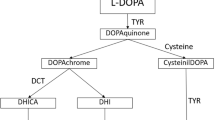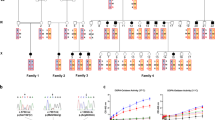Abstract
Oculocutaneous albinism (OCA) is a genetically heterogeneous hypopigmentation disorder. One of the two major autosomal recessive forms involves the tyrosinase gene (OCA1), while the other form (OCA2) has recently been associated with alterations of the P gene on chromosome 15. OCA2 is about twice as common as OCA1 in African and African–American populations. We now describe an interstitial deletion that removes a single exon of the P gene. In a large family from an inbred population of tri–racial origin, all individuals with OCA2 were found to be homozygous for this allele. Moreover, the same mutant P allele was detected in several unrelated African American individuals with OCA2, but not in Caucasians with OCA2. The detection of the same allele in two unrelated Africans with OCA2 indicates an African origin for this allele.
This is a preview of subscription content, access via your institution
Access options
Subscribe to this journal
Receive 12 print issues and online access
$209.00 per year
only $17.42 per issue
Buy this article
- Purchase on Springer Link
- Instant access to full article PDF
Prices may be subject to local taxes which are calculated during checkout
Similar content being viewed by others
References
Witkop, C.J. Jr., Hill, C.W., Desnick, S., Theis, J.K., Thorn, H.L. & Jenkins, M. Opthalmologic, biochemical, platelet and ultrastructural defects in the various types of oculocutaneous albinism. J. invest. Dermatol. 60, 443–456 (1973).
Witkop, C.J. Jr., Nance, W.E., Rawls, R.F. & White, J.G. Autosomal recessive oculocutaneous albinism in man: evidence for genetic heterogeneity. Am. J. hum. Genet. 22, 55–74 (1970).
Witkop, C.J. Jr., Quevedo, W.C., Fitzpatrick, T.B. & King, R.A. in The metabolic basis of inherited diseases, 6th edn (eds C.R., Scriver, A.L., Beaudet, W.S., Sly & D., Valle) 2905–2947 (McGraw-Hill, New York, 1989).
Okoro, A.N. Albinism in Nigeria. Br. J. Dermatol. 92, 485–492 (1975).
Aquaron, R. Oculocutaneous albinism In Cameroon: a 15-year follow-up study. Ophthalmic Paediat. Gen. 4, 255–263 (1990).
Kromberg, J.G.R. & Jenkins, T. Prevalence of albinism in the South African Negro. S. Mr. Med. J. 61, 383–386 (1982).
Witkop, C.J. Jr., Niswander, J.D., Bergsma, D.R., Workman, P.L. & White, J.G. Tyrosinase positive oculocutaneous albinism among the Zuni and the Brandywine triracial isolate: biochemical and clinical characteristics and fertility. Am. J. phys. Anthropol. 36, 397–405 (1972).
Silvers, W.K. The coat colors of mice (Springer-Verlag, New York, 1979).
Russell, E.S. A quantitative histological study of the pigment found in the coat-color mutants of the house mouse.lV. The nature of the effects of genie substitution in five major allelic series. Genetics 34, 146–166 (1949).
Hearing, V.J., Phillips, P. & Lutzner, M.A. The fine structure of melanosomes in coat color mutants of the mouse. J. Ult. Res. 43, 88–106 (1973).
Gardner, J.M. et al. The mouse pink-eyed dilution gene: association with human Prader-Willi and Angelman Syndromes. Science 257, 1121–1124 (1992).
Rinchik, E.M. et al. A gene for the mouse pink-eyed dilution locus and for human type II oculocutaneous albinism. Nature 361, 72–76 (1993).
Ramsay, M. et al. The tyrosinase-positive oculocutaneous albinism locus maps to chromosome 15q11.2–q12. Am. J. hum. Gen. 51, 879–884 (1992).
Lee, S-T. et al. Mutations of the P gene in oculocutaneous albinism, ocular albinism and Prader-Willi syndrome plus albinism. New Engl. J. Med. 330, 529–534 (1994).
Pearson, W.R. & Lipman, D.J. Improved tools for biological sequence comparison. Proc. natn. Acad. Sci. U.S.A. 85, 2444–2448 (1988).
Brilliant, M.H., Gondo, Y. & Eicher, E. Direct molecular identification of the mouse pink-eyed unstable mutation by genome scanning. Science 252, 566–569 (1991).
Church, G.M. & Gilbert, W. Genomic Sequencing. Proc. natn. Acad. Sci. U.S.A. 81, 1991–1995 (1988).
Sanger, F., Niklen, S. & Coulson, A.R. DNA sequencing with chain-terminating inhibitors. Proc. natn. Acad. Sci. U.S.A. 74, 5463–5467 (1977).
Author information
Authors and Affiliations
Rights and permissions
About this article
Cite this article
Durham-Pierre, D., Gardner, J., Nakatsu, Y. et al. African origin of an intragenic deletion of the human P gene in tyrosinase positive oculocutaneous albinism. Nat Genet 7, 176–179 (1994). https://doi.org/10.1038/ng0694-176
Received:
Accepted:
Issue Date:
DOI: https://doi.org/10.1038/ng0694-176
This article is cited by
-
The molecular landscape of oculocutaneous albinism in India and its therapeutic implications
European Journal of Human Genetics (2023)
-
P-Protein: A Novel Target for Skin-whitening Agent
Biotechnology and Bioprocess Engineering (2019)
-
Delineating the genetic heterogeneity of OCA in Hungarian patients
European Journal of Medical Research (2017)
-
Clinical evaluation and molecular screening of a large consecutive series of albino patients
Journal of Human Genetics (2017)
-
High resolution mapping of OCA2 intragenic rearrangements and identification of a founder effect associated with a deletion in Polish albino patients
Human Genetics (2011)



